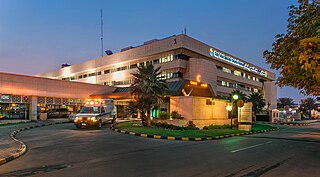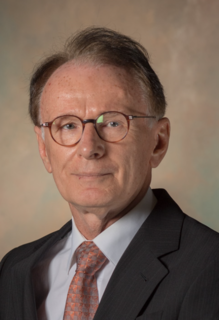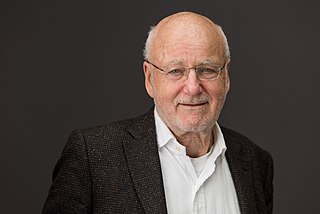Hematology is the branch of medicine concerned with the study of the cause, prognosis, treatment, and prevention of diseases related to blood. It involves treating diseases that affect the production of blood and its components, such as blood cells, hemoglobin, blood proteins, bone marrow, platelets, blood vessels, spleen, and the mechanism of coagulation. Such diseases might include hemophilia, blood clots (thrombus), other bleeding disorders, and blood cancers such as leukemia, multiple myeloma, and lymphoma. The laboratory analysis of blood is frequently performed by a medical technologist or medical laboratory scientist.
The National Institute of Arthritis and Musculoskeletal and Skin Diseases (NIAMS) is one of the institutes and centers that make up the National Institutes of Health, an agency of the United States Department of Health and Human Services (HHS).
The National Heart, Lung, and Blood Institute (NHLBI) is the third largest Institute of the National Institutes of Health, located in Bethesda, Maryland, United States. It is tasked with allocating about $3.6 billion in FY 2020 in tax revenue to advancing the understanding of the following issues: development and progression of disease, diagnosis of disease, treatment of disease, disease prevention, reduction of health care disparities within the American population, and advancing the effectiveness of the US medical system. NHLBI's Director is Gary H. Gibbons (2012–present).
Translational medicine is defined by the European Society for Translational Medicine as "an interdisciplinary branch of the biomedical field supported by three main pillars: benchside, bedside, and community". The goal of translational medicine is to combine disciplines, resources, expertise, and techniques within these pillars to promote enhancements in prevention, diagnosis, and therapies. Accordingly, translational medicine is a highly interdisciplinary field, the primary goal of which is to coalesce assets of various natures within the individual pillars in order to improve the global healthcare system significantly.
The American Association for Cancer Research (AACR) is the world's oldest and largest professional association related to cancer research. Based in Philadelphia, the AACR focuses on all aspects of cancer research, including basic, clinical, and translational research into the etiology, prevention, diagnosis, and treatment of cancer. Founded in 1907 by 11 physicians and scientists, the organization now has more than 50,000 members in 129 countries and territories. The mission of the AACR is to prevent and cure cancer through research, education, communication, collaboration, science policy and advocacy, and funding for cancer research.

A medical laboratory scientist (MLS) or clinical laboratory scientist (CLS) or medical technologist (MT) performs diagnostic testing of blood and body fluids in clinical laboratories. The scope of a medical laboratory scientist's work begins with the receipt of patient or client specimens and terminates with the delivery of test results to physicians and other healthcare providers. The utility of clinical diagnostic testing relies squarely on the validity of test methodology. To this end, much of the work done by medical laboratory scientists involves ensuring specimen quality, interpreting test results, data-logging, testing control products, performing calibration, maintenance, validation, and troubleshooting of instrumentation as well as performing statistical analyses to verify the accuracy and repeatability of testing. Medical laboratory scientists may also assist healthcare providers with test selection and specimen collection and are responsible for prompt verbal delivery of critical lab results. An estimated 70% of medical decisions are based on laboratory test results and MLS contributions affect 95% of a health system's costs.
Wake Forest University School of Medicine is the medical school of Wake Forest University, with two campuses located in Winston-Salem, North Carolina and Charlotte, North Carolina, United States. It is affiliated with Atrium Health Wake Forest Baptist, the academic medical center whose clinical arm is Atrium Health Wake Forest Baptist. In 2021, U.S. News & World Report ranked Wake Forest School of Medicine 48th best for research in the nation and 80th best for primary care. The School of Medicine also ranks in the top third of U.S. medical schools in funding from the National Institutes of Health (NIH).
The American Society of Hematology (ASH) is a professional organization representing hematologists. It was founded in 1958. Its annual meeting is held in December of every year and has attracted more than 30,000 attendees. The society publishes the medical journal Blood, the most cited peer-reviewed publication in the field, and Blood Advances, an online, peer-reviewed open-access journal.
Slobodan Obradov was a Serbian physician. In the course of his professional career he has developed the hematology specialization in former Yugoslavia and aided in world class research on the subject of blood related cancers.
Ulrich Rudolph Mahlknecht is an internationally renowned German/Italian physician scientist.

The NIH Intramural Research Program (IRP) is the internal research program of the National Institutes of Health (NIH), known for its synergistic approach to biomedical science. With 1,200 Principal Investigators and over 4,000 Postdoctoral Fellows conducting basic, translational, and clinical research, the NIH Intramural Research Program is the largest biomedical research institution on earth. The unique funding environment of the IRP facilitates opportunities to conduct both long-term and high-impact science that would otherwise be difficult to undertake. With rigorous external reviews ensuring that only the most outstanding research secures funding, the IRP is responsible for many scientific accomplishments, including the discovery of fluoride to prevent tooth decay, the use of lithium to manage bipolar disorder, and the creation of vaccines against hepatitis, Hemophilus influenzae (Hib), and human papillomavirus (HPV). In addition, the IRP has also produced or trained 21 Nobel Prize-winning scientists.

King Fahad Specialist Hospital-Dammam (KFSHD) is a hospital in the Eastern region of Saudi Arabia.

Ahmed Samy Khalifa was an Egyptian pediatric hematologist/oncologist. He established the specialty of Pediatric Hematology/Oncology at Ain Shams University. He treated thousands of children with thalassemia, leukemia and other hematologic and ontological diseases all over Egypt.
Olga Aleinikova — is a pediatric-oncohematologist, PhD, Doctor of Medical Science (1999), Professor (2003), Corresponding Member of the National Academy of Sciences of Belarus, Director of State Institution "Belarusian Research Center for Pediatric Oncology, Hematology and Immunology".

Carl H. June is an American immunologist and oncologist. He is currently the Richard W. Vague Professor in Immunotherapy in the Department of Pathology and Laboratory Medicine at the Perelman School of Medicine of the University of Pennsylvania. He is most well known for his research into T cell therapies for the treatment of cancer. In 2020 he was elected to the American Philosophical Society.

Musa Mirmammad oglu Abdullayev (27 November 1927, Masallı district, Azerbaijan SSR, USSR — 8 August 1979, Baku, Azerbaijan SSR, USSR) — Prominent hematologist of Azerbaijan, doctor of medicine, professor, philologist-translator. He was one of the eight members of the anti-Soviet nationalist student-youth political organization "Lightning" (İldırım), formed for the independence of Azerbaijan within 1942-1944.

Martin Körbling is a German-American internist and hematologist, university professor, medical researcher and pioneer of blood stem cell transplantation.
Christopher Hourigan is a physician-scientist known for work on measurable residual disease in acute myeloid leukemia.

Bob Löwenberg is a clinical hematologist/investigator. He is Professor of Hematology at Erasmus University Rotterdam.
Cynthia Dunbar is an American scientist and hematologist at the National Heart Lung and Blood Institute (NHLBI), which is part of the National Institutes of Health (NIH). She is the Branch Chief of the Translational Stem Cell Biology Branch.







